Serendipitous Juno Spacecraft Detections Shatter Ideas About Origin of Zodiacal Light
- Get link
- X
- Other Apps
TOPICS:AstronomyJunoMarsNASANASA Goddard Space Flight CenterPopular
By LONNIE SHEKHTMAN, NASA’S GODDARD SPACE FLIGHT CENTER MARCH 15, 2021
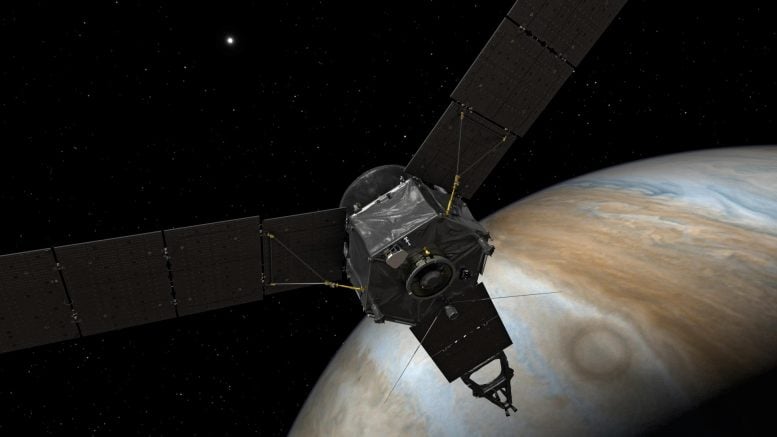
An illustration shows NASA’s Juno spacecraft as it entered orbit of Jupiter on July 4, 2016, after traveling for nearly five years and more than 1.7 billion miles. Credit: NASA/JPL/SwRI
Data from the NASA spacecraft’s journey to Jupiter suggests that Mars may be shedding dust into interplanetary space.
Look up to the night sky just before dawn, or after dusk, and you might see a faint column of light extending up from the horizon. That luminous glow is the zodiacal light, or sunlight reflected toward Earth by a cloud of tiny dust particles orbiting the Sun. Astronomers have long thought that the dust is brought into the inner solar system by a few of the asteroid and comet families that venture in from afar.
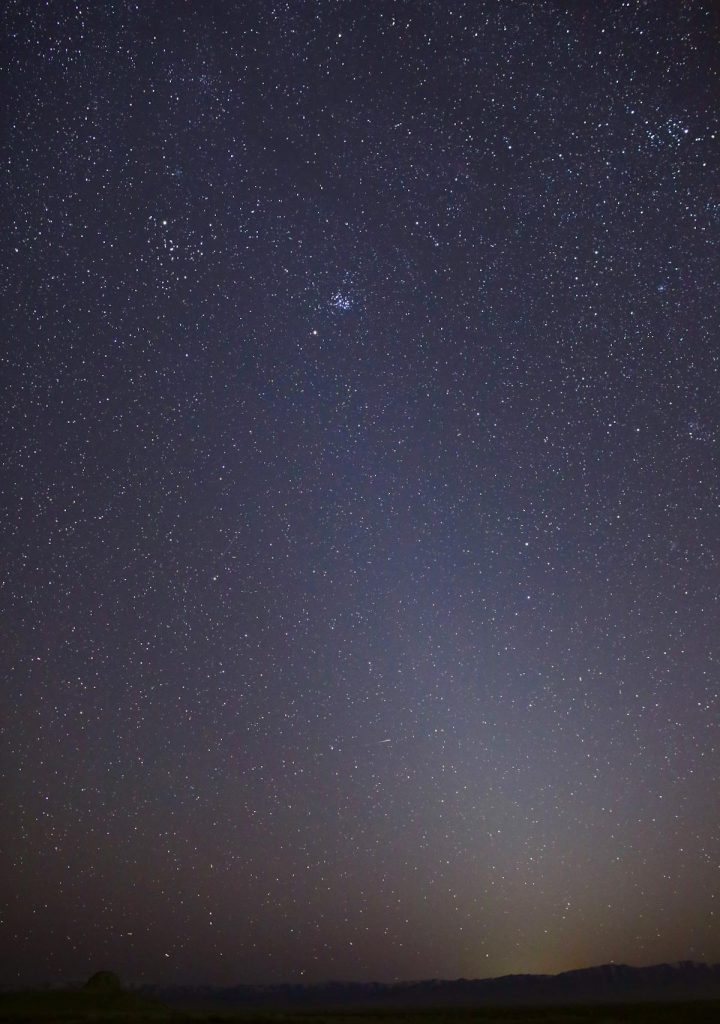
This photo shows the zodiacal light as it appeared on March 1, 2021, in Skull Valley, Utah. The Pleiades star cluster is visible near the top of the light column. Mars is just below that. Credits: NASA/Bill Dunford
But now, a team of Juno scientists argues that Mars may be the culprit. They first published their finding on November 11, 2020, in the Journal of Geophysical Research: Planets, with a final peer-reviewed paper published on March 9, 2021.
An instrument aboard the Juno spacecraft serendipitously detected dust particles slamming into the spacecraft during its journey from Earth to Jupiter. The impacts provided important clues to the origin and orbital evolution of the dust, resolving some mysterious variations of the zodiacal light.
Though their discovery has big implications, the scientists who spent years studying cosmic debris did not set out to do so. “I never thought we’d be looking for interplanetary dust,” said John Leif Jørgensen, a professor at the Technical University of Denmark.
Jørgensen designed the four star trackers that are part of Juno’s magnetometer investigation. These onboard cameras snap photos of the sky every quarter of a second to determine Juno’s orientation in space by recognizing star patterns in its images — an engineering task essential to the magnetometer’s accuracy.
But Jørgensen hoped his cameras might also catch sight of an undiscovered asteroid. So he programmed one camera to report things that appeared in multiple consecutive images but weren’t in the catalog of known celestial objects.
He didn’t expect to see much: Nearly all objects in the sky are accounted for in the star catalog. So when the camera started beaming down thousands of images of unidentifiable objects — streaks appearing then mysteriously disappearing — Jørgensen and his colleagues were baffled. “We were looking at the images and saying, ‘What could this be?’” he said.
Jørgensen and his team considered many plausible and some implausible causes. There was the unnerving possibility that the star camera had caught a leaking fuel tank on Juno. “We thought, ‘Something is really wrong,’” Jørgensen said. “The images looked like someone was shaking a dusty tablecloth out their window.”
It wasn’t until the researchers calculated the apparent size and velocity of the objects in the images that they finally realized something: Dust grains had smashed into Juno at about 10,000 miles (or 16,000 kilometers) per hour, chipping off submillimeter pieces. “Even though we’re talking about objects with only a tiny bit of mass, they pack a mean punch,” said Jack Connerney, Juno’s magnetometer investigation lead, and the mission’s deputy principal investigator, who’s based at NASA’s Goddard Space Flight Center in Greenbelt, Maryland.
As it turned out, the spray of debris was coming from Juno’s expansive solar panels — the biggest and most sensitive unintended dust detector ever built.
“Each piece of debris we tracked records the impact of an interplanetary dust particle, allowing us to compile a distribution of dust along Juno’s path,” Connerney said. Juno launched in 2011. After a deep-space maneuver in the asteroid belt in 2012, it returned to the inner solar system for an Earth gravity assist in 2013, which catapulted the spacecraft towards Jupiter.
This visualization shows NASA’s Juno’s spacecraft on its five-year flight path to Jupiter, beginning with its launch from NASA’s Kennedy Space Center in Florida in 2011. Credit: NASA’s Goddard Space Flight Center; flight path animation courtesy of NASA/JPL-Caltech/SwRI
Connerney and Jørgensen noticed that the majority of dust impacts were recorded between Earth and the asteroid belt, with gaps in the distribution related to the influence of Jupiter’s gravity. According to the scientists, this was a radical revelation. Before now, scientists have been unable to measure the distribution of these dust particles in space. Dedicated dust detectors have had limited collection areas and thus limited sensitivity to a sparse population of dust. They mostly count the more abundant and much smaller dust particles from interstellar space. In comparison, Juno’s expansive solar panels have 1,000 times more collection area than most dust detectors.
Juno scientists determined that the dust cloud ends at Earth because Earth’s gravity sucks up all the dust that gets near it. “That’s the dust we see as zodiacal light,” Jørgensen said.
As for the outer edge, around 2 astronomical units (AU) from the Sun (1 AU is the distance between Earth and the Sun), it ends just beyond Mars. At that point, the scientists report, the influence of Jupiter’s gravity acts as a barrier, preventing dust particles from crossing from the inner solar system into deep space. This same phenomenon, known as orbital resonance, also works the other way, where it blocks dust originating in deep space from passing into the inner solar system.
The profound influence of the gravity barrier indicates that the dust particles are in a nearly circular orbit around the Sun, Jørgensen said. “And the only object we know of in almost circular orbit around 2 AU is Mars, so the natural thought is that Mars is a source of this dust,” he said.
A team of Juno scientists argues that Mars may be responsible for the interplanetary dust behind the zodiacal light, a faint column of light extending up from the horizon. An instrument aboard the Juno spacecraft serendipitously detected dust particles slamming into the spacecraft during its journey from Earth to Jupiter. The impacts provided important clues to the origin and orbital evolution of the dust. Credit: NASA’s Goddard Space Flight Center
“The distribution of dust that we measure better be consistent with the variation of zodiacal light that has been observed,” Connerney said. The researchers developed a computer model to predict the light reflected by the dust cloud, dispersed by gravitational interaction with Jupiter that scatters the dust into a thicker disk. The scattering depends only on two quantities: the dust inclination to the ecliptic and its orbital eccentricity. When the researchers plugged in the orbital elements of Mars, the distribution accurately predicted the tell-tale signature of the variation of zodiacal light near the ecliptic. “That is, in my view, a confirmation that we know exactly how these particles are orbiting in our solar system,” Connerney said, “and where they originate.”
While there is good evidence now that Mars, the dustiest planet we know of, is the source of the zodiacal light, Jørgensen and his colleagues cannot yet explain how the dust could have escaped the grip of Martian gravity. They hope other scientists will help them.
In the meantime, the researchers note that finding the true distribution and density of dust particles in the solar system will help engineers design spacecraft materials that can better withstand dust impacts. Knowing the precise distribution of dust may also guide the design of flight paths for future spacecraft in order to avoid the highest concentration of particles. Tiny particles traveling at such high velocities can gouge up to 1,000 times their mass from a spacecraft.
Juno’s solar arrays escaped harm because the solar cells are well protected against impact on the back — or dark — side of the array by the support structure.
Reference: “Distribution of Interplanetary Dust Detected by the Juno Spacecraft and Its Contribution to the Zodiacal Light” by J. L. Jorgensen, M. Benn, J. E. P. Connerney, T. Denver, P. S. Jorgensen, A. C. Andersen and S. J. Bolton, 11 November 2020, JGR Planets.
DOI: 10.1029/2020JE006509
We recommend
- Surprising Discovery Revealed After Sifting Through Solar System DustJames Kelly, SciTechDaily, 2019
- Astronomers Deduce the Characteristics of NanodustStaff, SciTechDaily, 2013
- Asteroids, Comets and Other Small Objects Provide Clues of Mysterious Distant PastJames Kelly, SciTechDaily, 2018
- Incredible Jupiter Images from Juno, Shadow Jumping, and a New Cyclone DiscoveryMike ONeill, SciTechDaily, 2019
- NASA's Juno Spacecraft Spots Signs That "Sprites" or "Elves" Frolic in Jupiter's AtmosphereMike ONeill, SciTechDaily, 2020
- Juno gives starship-like view of Earth flybyPhys.org, 2013
- Advanced 3-D printed parts for NASA's Orion designed to hold up to extreme temperaturesby Nancy Owano et al., TechXplore.com
- Serendipitous Juno detections shatter ideas about origin of zodiacal lightby Lonnie Shekhtman et al., Phys.org, 2021
- Just two weeks in orbit causes changes in eyesMedicalXpress, 2013
- Angioedema Attacks: Orladeyo Approved by the FDA for PreventionMRP, 2020
MORE ON SCITECHDAILY
Incredible Jupiter Images from Juno, Shadow Jumping, and a New Cyclone Discovery
Juno Mission Discovers Astonishing Features Unlike Anything Else in Our Solar System
NASA’s Juno Mission Expands Into the Future – To Explore Jupiter and Its Rings and Moons
3D Juno Movie Reveals Cyclones and Anticyclones on Jupiter
AROUND THE WEB

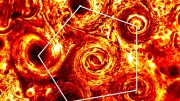
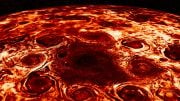
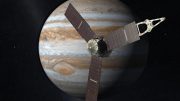
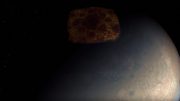

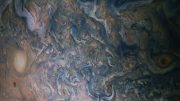
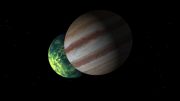
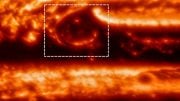





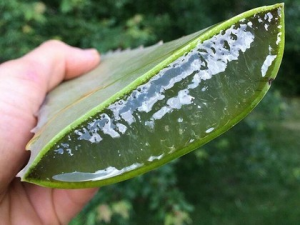
On Earth, the dust ends up in the bottom of the oceans, but on Mars it has nowhere to go, so it blows around the planet, year after century after millennium, the grains banging into each other and hard surfaces, being slowly worn down until the dust is so fine it makes talcum powder look like gravel. Dust storms on Mars blow that fine dust so high into the atmosphere that it blanks out the entire surface – Mariner 9 arrived to such a storm and everyone had to wait until it had settled.
As the dust settled from that storm, the first features that were revealed were the summits of Olympus Mons and the three biggest Tharsis volcanoes. If the dust can be blown that high into the atmosphere, it is possible that some of it might be picked up by the solar wind – Mars has no magnetic field, so the solar wind impinges on the upper atmosphere.